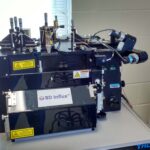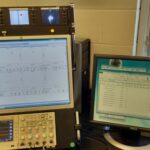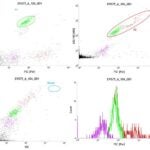General info
General Information about the instrument is available here from the manufacturer.
The BD Influx instrument at the MSRF is equipped with three excitation lasers at 355, 488 and 561 nm wavelengths.
An examination of open water samples for microbial abundance using the flow cytometer typically consists of two parts. In the first part of the analysis, photosynthetic organisms are quantified using autofluorescence. Organisms containing chlorophyll a (eukaryotic algae, pico eukaryotic algae, cyanobacteria) display a characteristic fluorescence signal at 692/40 nm when excited at 488 nm. Organisms containing phytocyanin (ex: synechococcus) additionally have a signal at 580/30 nm under that same excitation. A combination of scattering and fluorescence signals with the instrument set to trigger detection on the 692/40nm signal is thus used to distinguish the different populations of photosynthetic organisms present. In the second part of the analysis, heterotrophic bacteria may be quantified using SYBR staining. The SYBR dye, once intercalated with DNA, displays a fluorescence signal at 530/40 nm when excited at 488 nm. Using the dye and setting the flow cytometer to trigger detection on the 530/40 nm signal, one can essentially quantify all particles that contain DNA.
An example at the MSRF
An examination using flow cytometry of photosynthetic organisms in an open water sample collected from the Atlantic Ocean. Gates are preliminary drawn to highlight prochlorococcus (purple), synechococcus (green) and eukaryotic algae (red).



